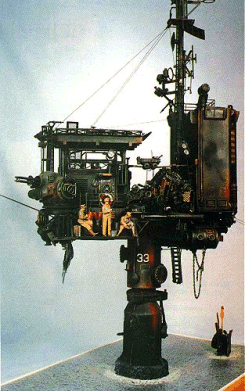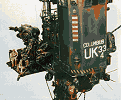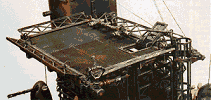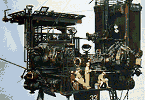
 |
|
Click for larger view
|

As the worlds ocean resources
of oil and food dwindle and the poaching of such becomes common place, governments
have had to provide not only aerial and naval surveillance of territory waters
but a string of permanent watch towers built strategically around the coast. These
towers are completely self sufficient providing the crews with all the creature
comforts necessary as they spend a minimum of 3 months on duty before shore leave.
Each tower has its own gyro landing facility, crew accommodation for eight, colbolt
powered energy system with solar back up, numerous radar devices and long range
over the horizon tracking systems, and its own self defence capability.
Construction:
I have always been fascinated
with ocean going oil rigs and old naval forts so combining these interests
with a passion for Sci-Fi the watch tower afforded the perfect combination.
The base is 3/4'' dressed pine with a timber beaded perimeter to provide the
ocean insert. For this I used the 'Faller' ocean sheeting overlaid on a mix
of humbrol paints deep blues and green with the clear overlay dry brushed in
white to give the appearance of white caps. The support tower and lower base
is made from PVC tube 30mm in diameter available from most local hardware suppliers.
The crews accommodation and work stations were attached directly to the top
of the tube and it was at this point that the work really started. I used 4
large Plastruct 'I' beams screwed to a plate on the top of the tube support
to provide the strength needed to take the weight of the structure.
I then cross supported those beams with smaller channels to provide further
rigidity. At this point I glued to the underside of the base, a number of fresh
water and fuel tanks required for such a tower. These tanks came from 1/25th
scale truck kits using fuel and air cylinders which with modification are ideal
for this type of component. I also connected all these tanks with the appropriate
plumbing required before I started on the decking itself.
 |
|
Click for larger view
|
The decking is a combination
of plastic sheeting and wire gauze, the latter being taken from vegetable strainers
flattened out and cut to desired shape before superglueing into the structure.
When painted and dry brushed, this material looks very similar to the grille decking
you find on walkways etc., on oil refineries.
The engineers station under the gyro pad is constructed using plastic card with
a few add ons from the parts box to depict ventilators, door handles etc. The
gyro pad is constructed from heaps of plastruct screwed to the 'I' beams of the
base as I felt glue would not have provided the strength. The ladders are scratch
built using 'Slatters' rod with the tunnel guards being standard plastruct items.
During the sequence of construction I made sure at all times that the plumbing
ran on from the tanks and generators etc. to connect up with outlets where required,
an item not to overlook because when the buildings are in place you have no access.
The drop down safety fencing on the gyro deck is from H.O. Railway bridge kits
which is about the ideal size for the siding.
The main electronics and surveillance tower is built using plastic card again
with a few add ons from the old parts box as needed. The tower lighting, search
lights and deck lights come from a combination of car and truck kits modified
to provide an accurate look. The crane and overhead gantry is built using heaps
of old 1/25th truck and car gearboxes, engine parts with scratch built hydraulics
and PVC plumbing. The communications mast is PVC tube with 'Slatters' strip wrapped
around at the appropriate points to give it a chunky effect. The aerials and radar
is sprue built up to the desired shape.
 |
|
Click for larger view
|
The crew are modified Tamiya
figures as are the boxes. buckets, provision items and other odds and sods on
the loading platform. I felt that the tower would obviously be very badly weathered
as it is open to the ravages of the sea and storms so particular care should be
taken when painting to get a balance of a structure that is weathered but not
to the point of being a rusted hulk. The whole structure was painted with numerous
'Tamiya' and 'Floquil' paints and dry brushed.
The decals are cut about super scale aircraft decals applied using the micro scale
system. One of the basic requirements I feel you need to not lose sight of in
this type of scratch building is to maintain a level of believability in your
subject matter and that the vehicle or building could work or be used. All the
plumbing, wiring, companion ways are all connected and have a function that relates
to the use of the Tower. Whilst this takes extra time in planning and building
your subject it adds to the believability factor and the acceptance of your model.
I estimate, between cups of coffee, working for a living, and watching my favourite
TV programme, the Watch Tower took about 150 hours.
 |
|
Click for larger view
|
Sprcifications:
- Height: 32 metres (from
low tide mark)
- Weight: 560 tons
- Energy System: 2 Colbolt
powered turbines housed in support base with solar back up.
- Crew: (8) Commander,
Defence System operators 2, Surveillance operators 2, Engineer, Cook, Gyro
Pilot.
- Defence System: 1 long
range multi-barrel anti-ship laser. 1 High velocity ground to air remote controlled
76mm cannon. 4 E.C.M.B. jamming units.
The tower unit itself is
mounted on a turntable system that can be rotated 360 degrees to provide the crew
with the best possible defensive or surveillance position. It also has a crane
by the loading platform for reprovision and general work as well as two 4 man
life boats.
The scene depicts the crew
taking advantage of calm seas and fine weather to rustle up a little fresh food
from good old mother nature.
Model & Text Copyright © 2005Laurie
Baker & PMMS
Click Browsers BACK button to return to list
Return to Home






